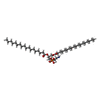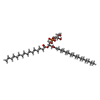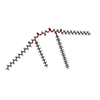+Search query
-Structure paper
| Title | Cryo-EM structures of cytochrome reveal bound phospholipids and ubiquinone-8 in a dynamic substrate binding site. |
|---|---|
| Journal, issue, pages | Proc Natl Acad Sci U S A, Vol. 118, Issue 34, Year 2021 |
| Publish date | Aug 24, 2021 |
 Authors Authors | Jiao Li / Long Han / Francesca Vallese / Ziqiao Ding / Sylvia K Choi / Sangjin Hong / Yanmei Luo / Bin Liu / Chun Kit Chan / Emad Tajkhorshid / Jiapeng Zhu / Oliver Clarke / Kai Zhang / Robert Gennis /   |
| PubMed Abstract | Two independent structures of the proton-pumping, respiratory cytochrome ubiquinol oxidase (cyt ) have been determined by cryogenic electron microscopy (cryo-EM) in styrene-maleic acid (SMA) ...Two independent structures of the proton-pumping, respiratory cytochrome ubiquinol oxidase (cyt ) have been determined by cryogenic electron microscopy (cryo-EM) in styrene-maleic acid (SMA) copolymer nanodiscs and in membrane scaffold protein (MSP) nanodiscs to 2.55- and 2.19-Å resolution, respectively. The structures include the metal redox centers (heme , heme , and Cu), the redox-active cross-linked histidine-tyrosine cofactor, and the internal water molecules in the proton-conducting D channel. Each structure also contains one equivalent of ubiquinone-8 (UQ8) in the substrate binding site as well as several phospholipid molecules. The isoprene side chain of UQ8 is clamped within a hydrophobic groove in subunit I by transmembrane helix TM0, which is only present in quinol oxidases and not in the closely related cytochrome oxidases. Both structures show carbonyl O1 of the UQ8 headgroup hydrogen bonded to D75 and R71 In both structures, residue H98 occupies two conformations. In conformation 1, H98 forms a hydrogen bond with carbonyl O4 of the UQ8 headgroup, but in conformation 2, the imidazole side chain of H98 has flipped to form a hydrogen bond with E14 at the N-terminal end of TM0. We propose that H98 dynamics facilitate proton transfer from ubiquinol to the periplasmic aqueous phase during oxidation of the substrate. Computational studies show that TM0 creates a channel, allowing access of water to the ubiquinol headgroup and to H98. |
 External links External links |  Proc Natl Acad Sci U S A / Proc Natl Acad Sci U S A /  PubMed:34417297 / PubMed:34417297 /  PubMed Central PubMed Central |
| Methods | EM (single particle) |
| Resolution | 2.19 - 3.25 Å |
| Structure data | EMDB-24265, PDB-7n9z: EMDB-30471, PDB-7cub: EMDB-30474, PDB-7cuq: EMDB-30475, PDB-7cuw:  EMDB-30817:  EMDB-30818:  EMDB-30819: |
| Chemicals |  ChemComp-HEM:  ChemComp-HEO:  ChemComp-CU:  ChemComp-3PE:  ChemComp-UQ8:  ChemComp-HOH:  ChemComp-LHG:  ChemComp-CDL:  ChemComp-ZN: |
| Source |
|
 Keywords Keywords | OXIDOREDUCTASE / proton pump / ubiquinol / oxidase / protein pump / MEMBRANE PROTEIN / Ubiquinone / Heme-copper Oxidoreductase / Electron transport / Bioenergetics |
 Movie
Movie Controller
Controller Structure viewers
Structure viewers About Yorodumi Papers
About Yorodumi Papers












